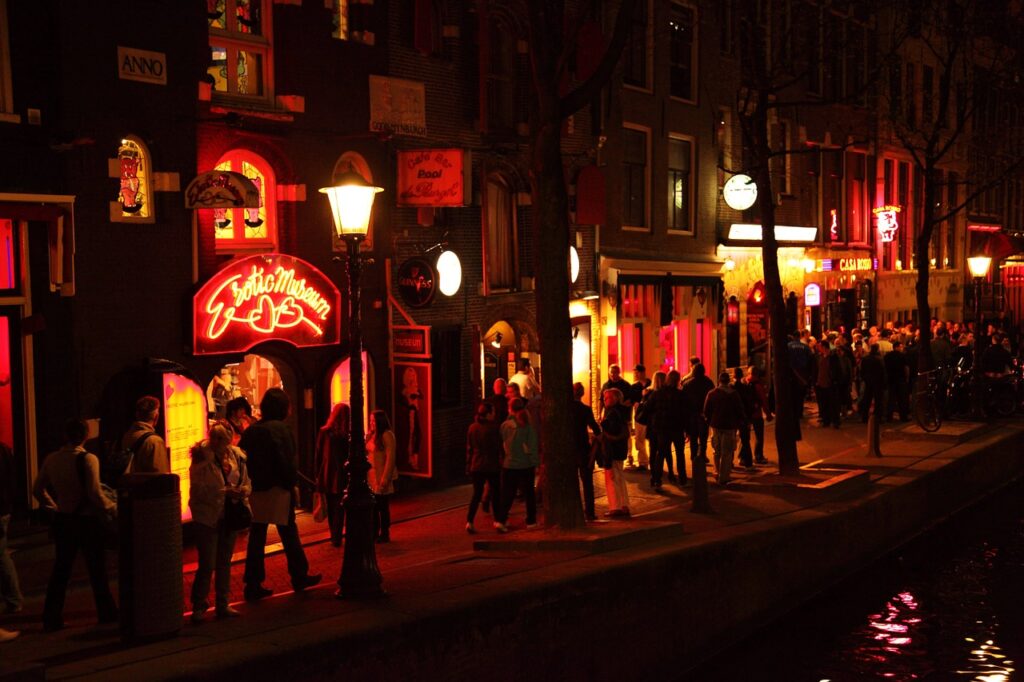The Amsterdam XXX is one of the most notorious symbols of the area that’s closely associated with the Red Light District Amsterdam. In popular culture, XXX has all sorts of meanings linked to debauchery, sexuality and other sorts of craziness that you’d be more likely than not to find in the Red Light District Amsterdam.
However, Amsterdam is not so audacious as to apply this symbol to their coat of arms in order to alert people that their red light district is worth seeing. This symbol actually has a lot of historical meaning and can be dated back as early as the year 1505.
Properly known as Andrew’s crosses, these symbols have a religious meaning like many of the symbology to be found all throughout Europe. This article will explain a bit more about the triple X symbol, what it means, and how it came to be associated with debauchery like it is nowadays.
The Amsterdam City Flag
Amsterdam is unique in that it is one of the few cities to have its own official city flag. The flag itself is quite simple. Three white Xs sit atop a black bar that is itself placed above a red background.
The design is simple and straightforward, but significant enough to stick in a person’s memory. Anyone who travels to Amsterdam will see this flag waving around all over the place. The flag seems to fit in very well because it captures both Amsterdam’s history and the present-day meaning of XXX which relates to sex, debauchery, and alcohol, which are Amsterdam’s primary tourist attractions.
Despite it all, the flag itself doesn’t mean anything of the sort. We know that it is based on the coat of arms of Amsterdam. However, the coat of arms itself is not entirely understood. There are a few ideas where this coat of arms originated from, but historians have not completely agreed where it came from.
The Amsterdam Coat of Arms
The city’s coat of arms contains, as a part of it, the three Xs that we see in the Amsterdam city flag. These are placed within a black band that is set down in the middle of a red shield. On either side of the shield are two lions, gripping it, and atop the shield sits a golden crown.
Beneath the whole thing and inscribed in beautiful lettering is the motto of Amsterdam. The words inscribed are Heldhaftig, Vastberaden, Barmhartig, which mean in English Valiant, Steadfast, Compassionate.
Unfortunately, nobody knows for sure the history of the coat of arms. There are a few ideas where it may have come from. These are the most popular theories.
St. Andrew’s Crosses
On the Coat of Arms, the black band running down the shield is graced by three Xs. These are believed to be St. Andrew’s Crosses. Although they appear in a different direction on the shield in the coat of arms compared to the flag, this isn’t the only instance of this happening. St. Andrew’s Crosses have appeared horizontally as well as vertically in different situations.
The story of St. Andrew does not have a happy ending. The fisherman and apostle was eventually martyred on an X-shape cross, and St. Andrew’s crosses are a representation of his martyrdom.
The symbol can be traced, in Amsterdam, back as early as 1505. In these earlier years, the town was a small fisherman’s village. The vessels that hailed from the town bore the same flag that you’ll see in the city today.
The Persijn Family
Other historians believe that a famous family known as the Persijns is more responsible for the XXX flag. This family of nobles once owned a significant amount of land throughout Amsterdam and the surrounding area, making their influence stronger than just about anyone at the time.
In this case, the original XXX can be traced back as early as 1280. Jan Persijn, who was considered the Lord of Amsterdam due to his family’s ownership of so much of the town’s land, had his lordship for two years between 1280 and 1282. The Persijn family coat of arms had a set of St. Andrew’s Crosses on them.
This family also owned a couple of small villages nearby, one of which has now become a suburb of Amsterdam itself. Both of the flags of these towns contain the image of St. Andrew’s crosses.
Coincidence? XXX, Amsterdam & X-Ratings
For years, Amsterdam was notorious as one of the only cities in the world that tourists could travel to solely for the purpose of getting stoned, roving the red light district, and soaking up a night of debauchery and other adult-themed fun.

XXX, in the modern day, is a symbol for sex and just about everything else that’s inappropriate for children. The fact that Amsterdam itself should boast a flag that contains a XXX that historically has no relation to sexuality is a very interesting coincidence.
In fact, XXX has only been a symbol for sex for a few decades. Much longer than that, XXX was a symbol used to mark the quality of beer. A beer cask that was marked with an X was approved and had passed the 10s duty, meaning that it was a quality drink.
Extra X stamps were often a trademark or marketing ploy intended to convince people that beer was of even higher quality, and ever since the symbol XXX has been used in popular media to indicate that the contents of a container include liquor.
X-rated movies first emerged in the 1970s. The X-rating generally suggested that the contents of movies included things inappropriate for children. Smut movie purveyors may have adapted to the idea of labeling “stronger” smut films with additional Xs, much like the beer-brewers of days gone. Free live XXX Amsterdam films remain popular to this day.
Conclusion
The Amsterdam XXX symbol has been labeled as one of the best city flags in the world. Despite that, it originally has no relationship to the sex and alcohol that Amsterdam is well-known for. The Amsterdam XXX relates to the coat of arms of the city, which can be accredited either to St. Andrew or the Persijn family.





